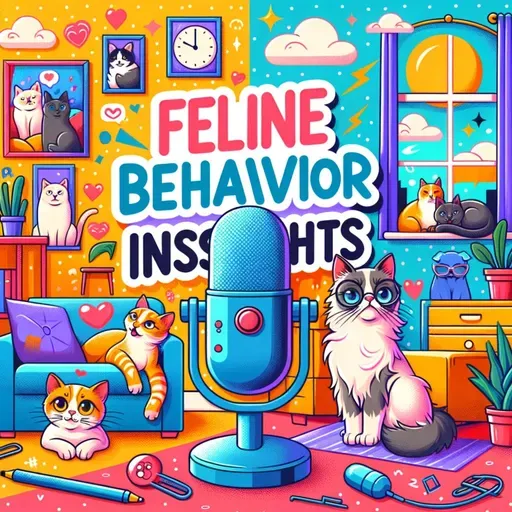
03 September 2025
Unraveling Feline Behavior: A Window into the Mysterious World of Cats
Feline Behavior Insights
About
Feline behavior is a fascinating window into the unique world of cats, full of subtle cues and complex motivations. Listeners often wonder what their cats are thinking or feeling, and understanding the signals cats send can help deepen the bond between feline and human companions. According to Tuft & Paw, a cat’s body language is a primary indicator of mood and motivation. For example, a relaxed cat will stretch out, exposing the belly or limbs, which means trust and comfort in their environment. In contrast, a tense cat will scrunch into a small ball, indicating anxiety, fear, or even pain.
Eyes and ears are equally telling. Best Friends Animal Society explains that calm cats tend to have slow blinking, relaxed eyelids, and neutral or slightly forward ears, which communicate a sense of safety. When ears are pinned back or the pupils widen, your cat may be scared or overstimulated. PetMD adds that a slow blink from a cat is a true feline form of affection and trust—you can try blinking slowly back to say they are safe with you.
The tail is the most expressive appendage in the feline body-language vocabulary. A tail that is upright with a slight curve at the tip signals happiness and confidence, reports PetMD. If the tail is low or tucked, the cat could be frightened, while a fluffed-up, high tail means the cat is attempting to look bigger and intimidate threats. Tuft & Paw notes that a quivering tail at greeting time is a sign of excitement and joy.
Vocalizations are also part of the mix, as MedVet points out. While meows are generally directed at people, purring can be a sign of both pleasure and pain—context always matters. If the cat’s posture is relaxed and loose, purring likely means contentment, but if the cat is hunched or stressed, purring could reflect discomfort. Hissing, growling, or constant yowling are clear signs your cat feels threatened, upset, or unwell.
Many listeners have observed their cats engaging in behaviors like kneading, head-butting, or face rubbing. These are generally affectionate gestures; according to Best Friends Animal Society, cats have scent glands in their faces and use these behaviors to mark familiar humans and objects as their own. Kneading, often called “making biscuits,” is an especially positive sign, echoing comforting behaviors from kittenhood.
Playful cats will chase invisible prey, swat at toys, and sometimes knock things off surfaces. MedVet explains this as satisfying their hunting instincts and natural curiosity, so it is typically healthy unless it becomes destructive. When a cat brings a listener a “gift,” like a toy or even prey, this is an instinctive behavior meant as a gesture of inclusion and care for their human family.
Thank you for tuning in and be sure to subscribe. This has been a quiet please production, for more check out quiet please dot ai.
For more http://www.quietplease.ai
Get the best deals https://amzn.to/3ODvOta
Eyes and ears are equally telling. Best Friends Animal Society explains that calm cats tend to have slow blinking, relaxed eyelids, and neutral or slightly forward ears, which communicate a sense of safety. When ears are pinned back or the pupils widen, your cat may be scared or overstimulated. PetMD adds that a slow blink from a cat is a true feline form of affection and trust—you can try blinking slowly back to say they are safe with you.
The tail is the most expressive appendage in the feline body-language vocabulary. A tail that is upright with a slight curve at the tip signals happiness and confidence, reports PetMD. If the tail is low or tucked, the cat could be frightened, while a fluffed-up, high tail means the cat is attempting to look bigger and intimidate threats. Tuft & Paw notes that a quivering tail at greeting time is a sign of excitement and joy.
Vocalizations are also part of the mix, as MedVet points out. While meows are generally directed at people, purring can be a sign of both pleasure and pain—context always matters. If the cat’s posture is relaxed and loose, purring likely means contentment, but if the cat is hunched or stressed, purring could reflect discomfort. Hissing, growling, or constant yowling are clear signs your cat feels threatened, upset, or unwell.
Many listeners have observed their cats engaging in behaviors like kneading, head-butting, or face rubbing. These are generally affectionate gestures; according to Best Friends Animal Society, cats have scent glands in their faces and use these behaviors to mark familiar humans and objects as their own. Kneading, often called “making biscuits,” is an especially positive sign, echoing comforting behaviors from kittenhood.
Playful cats will chase invisible prey, swat at toys, and sometimes knock things off surfaces. MedVet explains this as satisfying their hunting instincts and natural curiosity, so it is typically healthy unless it becomes destructive. When a cat brings a listener a “gift,” like a toy or even prey, this is an instinctive behavior meant as a gesture of inclusion and care for their human family.
Thank you for tuning in and be sure to subscribe. This has been a quiet please production, for more check out quiet please dot ai.
For more http://www.quietplease.ai
Get the best deals https://amzn.to/3ODvOta